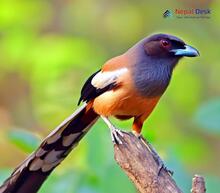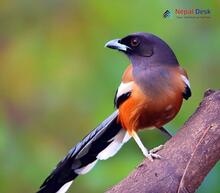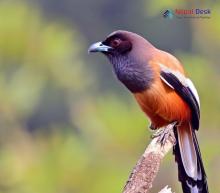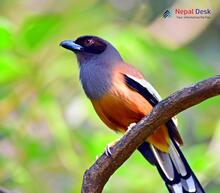The enigmatic Dendrocitta genus, commonly known as tree pies, has captured the interest of both biologists and bird enthusiasts. Found predominantly in Nepal and other Asian countries, these fascinating birds have been noted for their exceptional adaptability and striking features. In this blog post, we venture into the captivating realm of Dendrocitta by examining its origin, classification, appearance, ecological contributions, and presence in Nepal.
The Evolutionary Tale of Dendrocitta
The Dendrocitta's evolutionary path is still a matter of scientific discussion. However, experts believe that these birds share a common heritage with other members of the Corvidae family, which includes familiar species like crows, ravens, and magpies. Researchers are actively working to determine their specific relationships and uncover more details about their evolutionary past.
Unlocking the Classification Puzzle
The classification of the Dendrocitta genus is quite interesting. There are seven unique species across various geographical regions:
1. White-bellied Treepie (Dendrocitta leucogastra)
2. Rufous Treepie (Dendrocitta vagabunda)
3. Collared Treepie (Dendrocitta frontalis)
4. Andaman Treepie (Dendrocitta bayleii)
5. Bornean Treepie (Dendrocitta cinerascens)
6. Grey Treepie (Dendrocitta formosae)
7. Black-faced Treepie (Dendrocitta frontalis)
A Showcase of Morphological Excellence
Birds belonging to the Dendrocitta genus skillfully combine beauty with functionality—their remarkable physical traits are easily identifiable by bird lovers. Sporting long tails that allow for agile movements, these birds exhibit incredible navigation skills when maneuvering through dense forest canopies. Their eye-catching colors and patterns not only make them aesthetically pleasing but also serve as effective camouflage against predators.
The Importance of Ecological Balance
Dendrocitta birds are essential for maintaining the delicate balance within their inhabited ecosystems. Their diet consists primarily of fruits, seeds, insects, and small invertebrates. As a major contributor to seed dispersal, they help with forest regeneration processes that encourage biodiversity and support various other species. Moreover, Dendrocitta birds are considered indicators of environmental health since they are sensitive to habitat changes.
Nepal: A Biodiversity Haven
Several Dendrocitta species find their home in Nepal and have superbly adjusted to the diverse conditions present in the country. Often seen in subtropical, evergreen, and deciduous forests at varying elevations, their adaptability showcases Nepal's rich avian biodiversity. As a result, they serve as both a representation of natural heritage and as vital components within the Nepalese ecosystem.
In summary, the Dendrocitta genus comprises intriguing birds that draw researcher attention due to their evolutionary origins, taxonomy, appearances, ecological roles, and distribution. The intricate relationship among these factors highlights the importance of conserving these amazing creatures and their habitats for future generations to appreciate.




